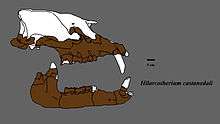Hilarcotherium
| Hilarcotherium Temporal range: 12 Ma | |
|---|---|
 | |
| Reconstructed skull of Hilarcotherium: the brown parts represents the fossils found. | |
| Scientific classification | |
| Kingdom: | Animalia |
| Phylum: | Chordata |
| Class: | Mammalia |
| Infraclass: | Placentalia |
| Order: | Astrapotheria |
| Family: | Astrapotheriidae |
| Subfamily: | Uruguaytheriinae |
| Genus: | Hilarcotherium Vallejo-Pareja et al.,[1] 2015 |
| species | |
|
Hilarcotherium castanedaii Vallejo-Pareja et al.,[1] 2015 (type species) | |
Hilarcotherium is an extinct genus of astrapotheriid mammal that lived in South America during the middle Miocene. The type and only known species is H. castanedaii, found in sediments of the La Victoria Formation in the Tolima Department in Colombia.[1]
Discovery
The remains of Hilarcotherium were discovered by José Alfredo Castañeda, who found them in the Malnombre Creek in the Hilarco village located near the town of Purificación, in Tolima. This area, in the valley of the Upper Magdalena River, correspond to the La Victoria Formation, that along the Villavieja Formation makes the Honda Group, dating from the Middle Miocene, made between 13-11.8 million years ago and it has provided a remarkable fossil site known as La Venta, although the lack of key fossil does not allow establish accurately the membership of the Hilarco site to the formation.[1] The remains of Hilarcotherium were collected by dr. María Páramo and Gerardo Vargas, who took them to the Geological Museum José Royo y Gómez of Ingeominas (former name of Colombian Geological Service) in Bogotá for study and preservation. In February 2015 these remains were officially named, although the name Hilarcotherium castanedaii was released earlier and informally in conference abstracts.[2] The genus name is derived from the Hilarco site and the term in Latinized Greek therium, meaning "beast", while the species name castanedaii is in recognition to Castañeda, by finding and reporting the find.[1]
Description
The only known specimen of Hilarcotherium is the holotype, IGM p881231. This consists of fragments of skull, a partial jaw, the vertebral ramus of a dorsal rib, a complete left humerus and an incisor tooth associated. The skull includes the rostrum area, the palate with the fourth premolar (P4) and the three upper molars (M1-M2-M3) plus part of the zygomatic arch and the braincase, but lacks of the upper canines and the top portion of the skull. The premaxilla shows no sign of having teeth, as in other astrapotheres. The jaw missing the incisors, the crown of the fourth premolar and the left mandibular ramus, but has the roots of the teeth of the right side and a broken canine with an oval cross section. It has however the sockets for three incisors on each side of the jaw, which is a plesiomorphic feature, as his other relatives as Xenastrapotherium had two.[1]
The humerus measures 45 centimeters in length, with a head of 84 mm at its widest and oriented backwards with a convex form. Moreover, as in Astrapotherium, the bone thickness decreases as it approaches its lower (distal) end.[1]
Analyses performed with his molars and humerus indicate that weight range of Hilarcotherium would be between 1187-1369 kg, which would be comparable to the modern black rhinoceros. Between astrapotheres, this size is equivalent to an "intermediate" range, since it is greater than that of genus as Comahuetherium (324-504 kg) and Astrapothericulus (956 kg), and similar to Xenastrapotherium and Astrapotherium? ruderarium, but lower than in the larger genera as Astrapotherium (1600-3500 kg), Granastrapotherium (3100 kg) and Parastrapotherium (3484 - 4117 kg) [3] This indicates that the large body size is a trait that developed early in the group, but the gigantic size, of more than 3 tons, evolved only on three separate occasions.[1]
Phylogeny
Hilarcotherium belongs to the family Astrapotheriidae, the family of advanced astrapotheres characterized by its developed tusks, separated by a diastema of the other teeth, the retracted nasal bones that indicate the presence of a trunk in his snout and the flattened astragalus. Within this group, Hilarcotherium shares with Xenastrapotherium, Uruguaytherium and Granastrapotherium the lower canines that are horizontally inserted into the jaw, in addition to the characteristics of the molars (without labial cingulum, an inner protuberance of the molars), indicating that Hilarcotherium and the others genera already mentioned belongs to the subfamily Uruguaytheriinae, a group that colonized the equatorial region of South America during the Miocene until their extinction in the middle of such period, in contrast with other astrapotheres only known in the south of the continent.[1]
Cladogram based in the phylogenetic analysis published in the original description article by Vallejo-Pareja et al., 2015, showing the position of Hilarcotherium:[1]
| |
Eoastrapostylops | ||||||||||||||||||||||||||||||||||||||||||||||||||||||||||||||||||||||||||||||
| | |||||||||||||||||||||||||||||||||||||||||||||||||||||||||||||||||||||||||||||||
| |
| ||||||||||||||||||||||||||||||||||||||||||||||||||||||||||||||||||||||||||||||
| |
References
- 1 2 3 4 5 6 7 8 9 10 Vallejo-Pareja, M. C.; Carrillo, J. D.; Moreno-Bernal, J. W.; Pardo-Jaramillo, M.; Rodriguez-Gonzalez, D. F.; Muñoz-Duran, J. (2015). "Hilarcotherium castanedaii, gen. et sp. nov., a new Miocene astrapothere (Mammalia, Astrapotheriidae) from the Upper Magdalena Valley, Colombia". Journal of Vertebrate Paleontology. 35 (2): e903960. doi:10.1080/02724634.2014.903960. (subscription required (help)).
- ↑ Pardo Jaramillo, M.; Rodríguez González, D. F.; Vallejo Pareja, María Camila; Carrillo Sánchez, J. D.; Muñoz Durán, J.; Moreno Bernal, J. W. (2010). Un nuevo género y especie de Astrapotheriidae del Mioceno del Valle Superior del río Magdalena, Colombia [A new genus and species of Miocene astrapotheriidae (from) the upper Magdalena River, Colombia]. X Congreso Argentino de Paleontología y Bioestratigrafía-VII Congreso Latinoamericano de Paleontología (in Spanish). Universidad Nacional de La Plata - Facultad de Ciencias Naturales y Museo.
- ↑ Kramarz, Alejandro G.; Bond, Mariano (2008). "Revision of Parastrapotherium (Mammalia, Astrapotheria) and other Deseadan astrapotheres of Patagonia". Ameghiniana. 45 (3). Retrieved March 2013. Check date values in:
|access-date=(help)